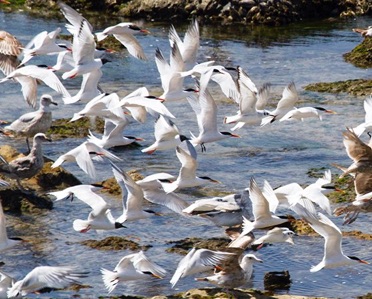Gray Whales Count

GWC Reports
2014
2016

All information and images are copyrighted by Gray Whales Count and the photographers. Data are freely available.
We ask that any material be properly credited within a presentation. We would also appreciate being notified, and forwarded a PDF, if appropriate. Please also consider supporting our work with a donation.
2015
2013
2012
2011
2010
2009
2008
2007
2017













Reports help us, as well as curious others, see particularities and “cumularities” in what we are doing. A goal in our Gray Whales Count survey is determining how many gray whales use the nearshore of the Santa Barbara Channel on their northbound migration. Others have determined that through the Southern California Bight—where we are counting—the whales travel a variety of routes. While, north of Point Conception, most of the migration adheres to a narrow path northbound and southbound.
The whales migrate 24/7 in one of the longest mammal migrations in the world. Our survey is a sample: a third of a day (in acceptable sea and weather conditions) approximately 100 consecutive days from midish February towards the end of May. In that time, we monitor two, distinct phases:
1) General Migration of males and females, mature and juvenile, not associated with mothers and calves; and 2) the Mother/calf migration, pairs and groups of pairs, in which each mother escorts her calf to feeding waters off Alaska for the first time. Both phases use this particular corridor for what may be completely different reasons.

One of the reports on this page is Estimates. Working in collaboration with scientists at NOAA Southwest Fisheries Science Center (SWFSC), we have been able to use our raw data to calculate estimates of the numbers of whales in each phase that passes Counter Point. In so doing, we are able to compare our past annual surveys and compare our estimates to SWFSC estimates to identify fluctuations in the annual migration and calf production.
Gray Whales Count operates from mid-February though about the end on May. The Count records that continual observation, recording the numbers of whales and calves sighted on-effort across our survey.
The two phases can overlap. To prepare our estimates, we must analyze our data and distinguish sightings and effort hours for each phase.
Being at Counter Point from winter well-into spring,
we are fortunate to see changes in the ocean environment. We see bottlenose dolphins almost
every day. Common dolphins, in sometimes huge groups, splash by us a bit further offshore; and, lately, we have gotten used to seeing Pacific white-sided dolphins routinely. California sea lions are all over
the place, so much so that we only document them
if they come ashore in need of a rescue. We seem to have between four and eight harbor seals who prefer the kelp east of us in front of Isla Vista. And, occasionally, we see rarer-to-these-parts pinnipeds: northern elephant seals and northern fur seals.
Southern sea otters are rarer than whales in this area. We have been fortunate to see a large accumulation of at least 36 in the Isla Vista Kelp, back in 2008; and, in 2016, for about six weeks on many days, we saw up to 5 otters in the kelp and waves in front of us.

In addition to northbound gray whales, we see some southbound gray whales in February and March, even sometimes in April. Humpbacks show up soon after we start. And, we have seen blue, fin, and minke whales. The rarer dolphins we have documented include Risso’s dolphins and killer whales. Fortunately, we have not had to experience a killer whale attack on gray whales or any other marine mammal during our survey.
All sightings have been entered on our datasheets. And, with our reports, we can focus on different species and behaviors, as well as create the Estimates.
We have re-made several of our reports and even withheld some in an effort to clean house. Even so,
the data are available, and we are happy to consider complying with specific requests.
If there are any problems downloading the PDFs and/or there are mistakes that need correcting in the reports, please let us know.
Thank you for caring and paying attention.


Andrea Dransfield, Project Coordinator | 805-618-5768 | [email protected]
© Gray Whales Count, 2020. All rights reserved.